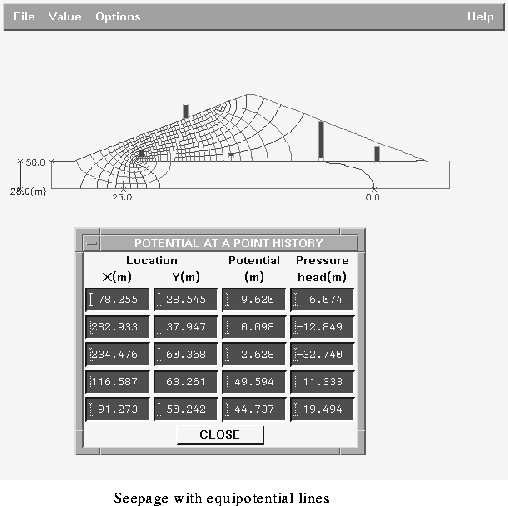Table of Contents
Malcolm Bolton, Ruth Thomas, Douglas Robertson
Cambridge
Other applications or tools of this site: SoftSpec
To the list of Colos applicati
ons
SEEPAGE is a simulation application which allows the user to explore the migration of ground water through water retaining structures.
The program does this by generating flownets for the following categories of commonly occurring geotechnical problems:
- flow beneath a cantilever retaining wall;
- flow through an earth dam;
- flow beneath a concrete dam with cut-off;

A finite element mesh is generated automatically to cover the area inside the boundaries. Laplace's equation is then solved both for the potential and stream functions using the finite element technique. The boundary conditions for the stream function are obtained from the solution of the potential function so that curvelinear squares are produced.
A simple contouring routine is used to obtain the lines of constant potential and flow. Also available to the user are measurements of pressure and potential and details of the travel of pollutants with time through the structure.
Understanding and an intuitive feel for the flow of ground water round water retaining structures is important to the practising civil engineer. In particular, they should fully understand the difference between potential and pressure.
To an engineer an important idea to grasp is the trade-off which takes place between cost and safety in design - this can be investigated using the SEEPAGE program. The program also allows the student to explore and to begin to develop the intuitive feel for behaviour of these complex systems which it may take a practicing engineer in the field many years to gain.
Past approach at Cambridge in teaching this subject was to use a laboratory exercise where the students investigated flow around a sand filled model of a sheet pile cut off. Obviously this was a fairly limited exercise as only one example geometry could be studied. Students found flow nets difficult to visualise and were reluctant to answer examination questions in the subject, or to carry the subject on to a higher level.
The approach used at Cambridge is to use the software in parallel with, and to augment laboratory simulation. The student investigates pressure and potentials in a laboratory model and then moves to the computer to further investigate the problem.
The package has also been used in example questions set for students to work on their own and used in lecture demonstrations.
With careful manipulation of the geometry these 3 cases can cover many other forms of problem including, for instance, land fill sites. Knowing exactly what parameters to use and to how approximate them to achieve a meaningful simulation is a skill that engineers must develop. The application will be incorporated within a hypermedia browsing environment with a view to development of this skill.
A student can choose one of the 3 water retaining structures" to replace "of the three above categories to investigate and then change the geometry of the boundaries that define it. (S)he can also change the potential of the upstream and downstream boundaries of each category and enter a permeability for the soil. Output is in the form of a flownet with ten potential intervals, the water pressure at any selected point can then be output directly. Flow quantities are automatically displayed, consistent with input information concerning the permeability, which is taken to be constant and isotropic throughout the flow region.
A student can also see the passage of pollutant through the structure and investigate factors such as porosity and potential in the timing of this phenomenon.
Further development of the simulation will includes the introduction of layered and or anisotropic soil.
Use of a finite element technique necessitates a powerful computer as does use of animation to show pollution migration. If the student is not to be discouraged from exploration, the time to solve the problem must not be excessive. On machines slower than the HP720 it could take upwards of a minute to produce a flow net.
SEEPAGE is a program designed for second year undergraduates who will have attended one term of lectures on soil mechanics.
Evaluation, both formative and summative, will be carried out as part of the INTERACT project and will include this package. It will be used in teaching approximately 360 2nd year students per year.
Past use of a simpler SEEPAGE package (without pollution migration options or multiple windows) led to anecdotal evidence that a larger number of students were answering exam questions on the subject as well choosing to specialise in the soil mechanics option for further study.

